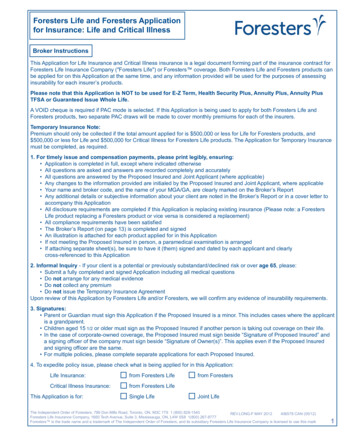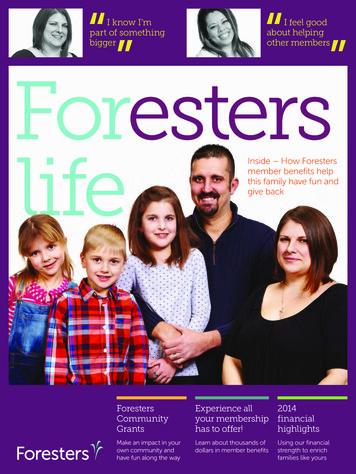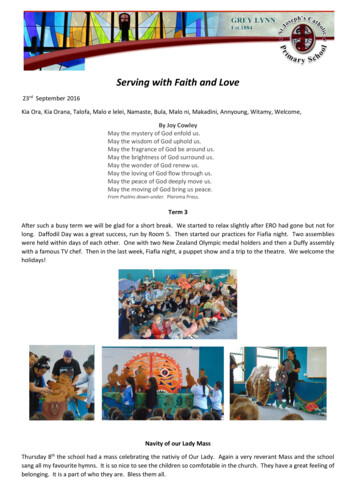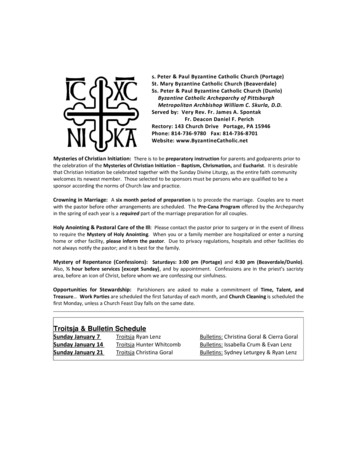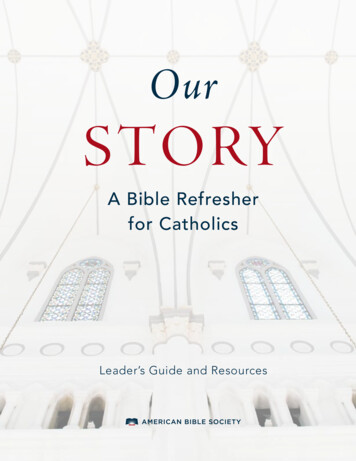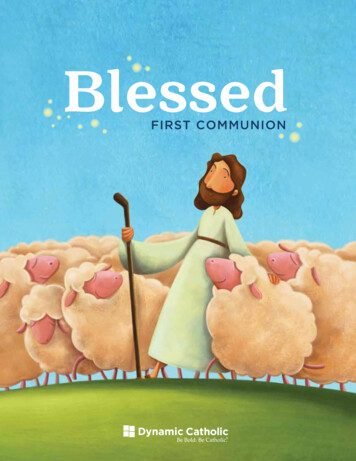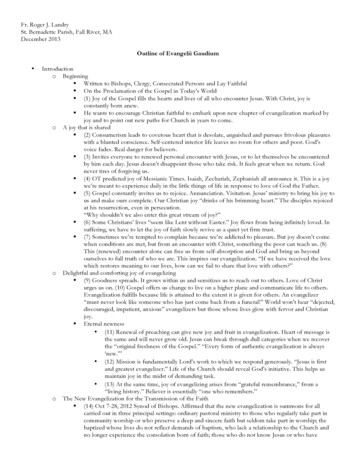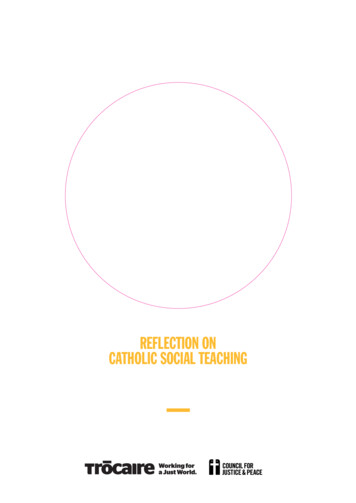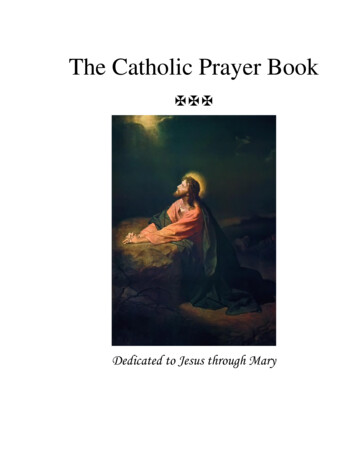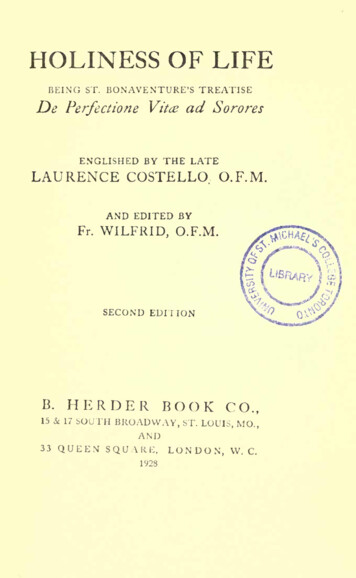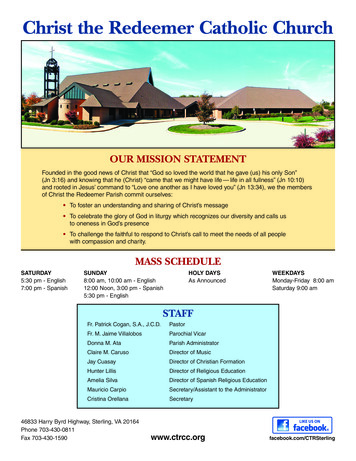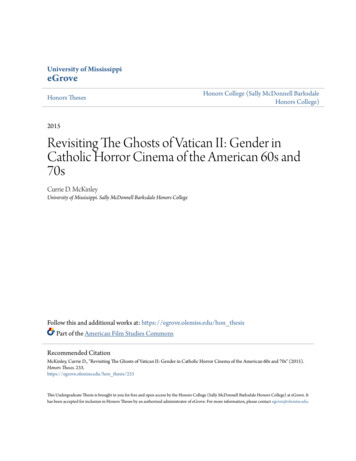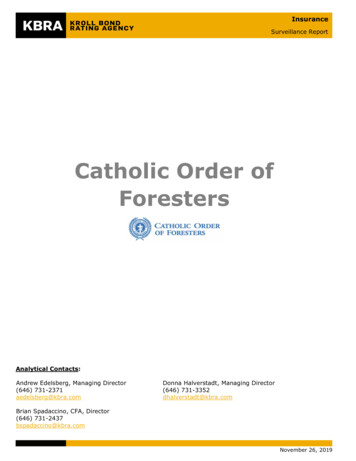
Transcription
InsuranceSurveillance ReportCatholic Order ofForestersAnalytical Contacts:Andrew Edelsberg, Managing Director(646) 731-2371aedelsberg@kbra.comDonna Halverstadt, Managing Director(646) 731-3352dhalverstadt@kbra.comBrian Spadaccino, CFA, Director(646) 731-2437bspadaccino@kbra.comNovember 26, 2019
Kroll Bond Rating Agency (KBRA) has affirmed the following insurance financial strength rating (IFSR) ofCatholic Order of Foresters (COF or the Order) based on KBRA’s Global Insurer & Insurance HoldingCompany Rating Methodology, published on October 10, 2017.RatingsEntityCatholic Order of edCOF started as the Illinois Catholic Order of Foresters on May 24, 1883 in Chicago. The Order was authorizedto transact business as a fraternal benefit society in July of 1895, following the passage of the Illinois FraternalAct of 1893A few years later, “Illinois” was dropped from the name as COF became a nationwide fraternalorganization. The name of the society exemplifies the care that true foresters have for woodlands and othernatural resources. Catholic Order of Foresters maintains its home office in Naperville, Illinois.COF was an organization for men and boys until 1952, when women and girls were invited to join. Currently,the Order has roughly 108,000 members nationwide, and is licensed in 32 states as well as Washington D.C.(although the company actively writes in 16 states). The majority of COF’s business is generated in Indiana,Illinois, Iowa, Kentucky, Michigan, Minnesota, Nebraska, Ohio, and Wisconsin. The Order offers annuities,term and whole life insurance, and universal life insurance products to its members.What sets the Order apart from other life insurance companies is that each member holds a membershipcertificate and is therefore eligible for COF’s unique value-added fraternal benefits that enhance membership(e.g., scholarships and tuition assistance). The Order is comprised of chartered state and local courts whosemembers perform fraternal and charitable activities.Rating Rationale:The rating reflects COF’s solid balance sheet, considerable membership base, profitable operations,diversified business mix, and long-term strategic focus. COF is the third-largest Catholic fraternalmembership society (based on net admitted assets as of June 30, 2019), helping members achieve financialsecurity while supporting the Catholic community through fraternal outreach. The Order is focused on writingcontinuous pay life products and growing membership within its current product offerings. KBRA believesparticipating whole life to be the industry’s most creditworthy product. COF has reported solid, consistentprofitability across its life and annuity business lines, which has resulted in steady, predictable capital growth.The Order is also engaging with its distribution to customize its products, and deploying service initiatives,to better reach a younger target consumer. Moreover, KBRA believes the Order has sound liquidity, favorablelapse experience, strong persistency and good financial flexibility, as evidenced by ample access to capital,with no debt outstanding.Balancing these strengths are COF’s noteworthy exposure to spread compression within its legacy annuitybook due to relatively high crediting rates. Additionally, although manageable, the society’s investmentportfolio contains notable exposure to higher-risk assets such as below investment grade bonds, equities andmortgage loans, and takes on liquidity and structural risk through material investments in privateplacements, structured bonds, CLOs and RMBS. KBRA notes that equity investments are part of COF’s noncore allocation, hence they do not back insurance liabilities. Like its fraternal peers, COF has been challengedto reverse the decline in membership. Lastly, KBRA will continue to monitor the results of COF’s recapturedclosed long-term care block, which is likely to necessitate reserve increases in the near to medium term.Catholic Order of ForestersPage 2November 26, 2019
Key Rating DriversCredit Strengths Sound capitalization with favorable trends in capital and surplus. Total adjusted capital was up 2.4% at2Q19 from YE18, but down 6.5% from YE17, when it reached its all-time high of 97.7 million. Well-established fraternal with conservative management team and significant membership base ofroughly 108,000 members Diversified business mix with steady profits from both its life insurance and annuity lines of business.Reserve mix is roughly 50% life/50% annuities; 2018 was the first year since the 1990s that COF’s lifepremium ( 32.2 million) was greater than annuity premiums and deposits ( 28.1 million). Focus on sales of participating whole life. COF has been able to increase its average face of new businessand average premium per life policy consistently since 2012 (adjusting for a large family program placedin 2015). All incentive compensation is driven by traditional life production. Continued focus on developing and recruiting younger agents. Approximately 48% of COF’s top 40agents (who account for 97% of annuity production) are under the age of 50. Strong affinity relationship with Catholic communities presents value proposition to middle CatholicAmerica and facilitates strong persistency and low lapse rates for existing membersCredit Constraints Annuity block susceptible to spread compression and disintermediation risk COF’s membership continues to have a net decline due to aging out of current policyholders. The Order’starget market of middle-income families, business owners and pre-retirees is consistent with manycommercial carriers as well as peer fraternals. Significant drop in net investment income year-over-year driven by lower new money rates as well as achange in income recognition for its SBA bond portfolio. These items caused the Order to report a netloss in 2018 of 5.4 million. KBRA notes that COF issues participating life dividends (i.e. refunds tomembers) annually; these have ranged between 6.3 and 7.1 million each year for the last five years. Notable exposure to higher-risk assets, especially those with potential liquidity risk and/or reinvestmentrisk Closed block of recaptured long-term care policies was underpriced and has necessitated reservestrengthening. KBRA believes that reserve strengthening will continue to be a headwind on overalloperating results in the near to medium term.Financial MetricsCatholic Order Of Foresters ( 000s)BALANCE SHEETTotal Admitted AssetsSurplusAsset Valuation Reserve (AVR)Total Adjusted Capital (TAC)Chg in TAC from Prior PeriodC&S to Liabilities (excl. Separate Accts)NAIC RBC (CAL)BIG Bonds/TACHigh-Risk Assets/TACPROFITABILITYNet Gain from Operations Before RefundsNet IncomeNet Investment Yield*1 Yr. Operating ROE*Return on Admitted Assets*Key Insurance Metrics% Annuities w/o Surrender ChargeAvg. Face Amt. of Life New BusinessLife Ins as % of Total ReservesLapse RatioCurrent LiquidityGeneral Ins. Exp. to Total Admitted AssetsCatholic Order of Foresters2Q2019 1,201,69078,18613,6752018 1,202,04882,3597,32191,8612.4%7.0%NA59.0%91.9% 1,281137NANA0.0%NANANANA96.5%NA2017 1,195,87588,6779,00189,680-8.2%7.4%333%72.7%114.4% 2,448(5,433)4.34%-4.7%-0.5% 80.9%24444.1%6.1%97.6%1.48%Page 32016 1,140,02481,7998,88297,6787.7%8.0%396%58.5%80.9% 16,32610,8895.97%11.7%0.9% 80.5%19843.4%4.2%98.0%1.43%2015 1,095,71079,0868,03090,6824.1%7.7%410%58.7%82.4% 9,3722,4605.51%3.0%0.2% 81.1%14943.8%3.1%98.2%1.64%2014 1,050,22772,72011,21087,1163.8%7.8%381%34.6%74.5% 16,4728,2055.80%12.5%0.8% %73.5% 52% November 26, 2019
Recent DevelopmentsCorporate Governance Greg Temple succeeded David Huber as President/CEO as of August 1, 2019. Temple is the first CEOof the society who is not affiliated with a membership position. Huber will remain board chairman. The CEO is a member of the Executive Committee but does not have a role on the board. The boardcontinues to be elected directly from the membership; the vetting process is being augmented. Thereis currently no ability to appoint independent directors. However, KBRA believes the organization isworking towards that goal.Operating Performance Admitted assets were essentially flat YE18 compared to YE17 (as well as 2Q19 vs. YE18).At the end of Q2 2019, admitted assets were 1.20 billion Total adjusted capital (TAC) declined 8.2% year-over-year to 89.7 million at YE18.However, TAC increased 2.4% during the first 6 months of 2019 to 91.9 million Insurance in force increased 211.8 million (6.1%) at YE18 to 3.68 billion from 3.47 billion at YE17 Total life premium decreased slightly in 2018 by 600K compared to 2017.First year life premium increased by 57.2% in 2018 to 1.8 million Annuity premium was down 6.9 million (21.2%) in 2018 compared to 2017.This was driven by a conscious effort over the last few years to move new annuity deposits into thesingle premium UL product. Net investment income (NII) decreased by 16.5 in 2018 compared to 2017.The decrease in NII was due to a change in the way COF accounted for income on its legacy RMBS,specifically SBA IOs. This drove the 2018 net loss of 5.4 million (compared to 2017 net income of 10.9 million). As such, net investment yield declined from 5.95% to 4.32%. General expenses increased 4.3% to 17.3 million in 2018 from 16.5 million in 2017.The increase is due primarily to investments in the business such as additions to field forcemanagement as well as system and technology improvements.Product/Business Plans Continuing efforts to market annual pay life products and focus on geographic expansion with thebuild-out of the general agencies (GAs). Goal is to develop 15 to 18 GAs. COF is gaining some traction and momentum with engaging new members, specifically the youngercohorts like Gen Y/MillennialsMergers/Acquisitions No active mergers or acquisitions ongoing; COF believes the opportunity is with another Catholicfraternal and not with any of the small societiesHistory of FraternalsFraternal benefit societies (fraternals) came about in the late 1800s to assist the large number of immigrantscoming to America. One of their more significant needs was to provide for families’ financial well-being in theevent of untimely death of the breadwinner. Although a conventional life insurer could also provide theseservices, fraternals were unique in that they united people through a common bond such as religion, ethnicity,or occupation. Moreover, the mission of these organizations has been to support their communities.Fraternals provide fertile ground for relevant, important, and meaningful community service activities thatmake a difference in the lives of individuals and enhance their quality of life.These not-for-profit, policyholder-owned companies are comparable to mutual life insurers in certainrespects, in particular their focus on selling permanent life insurance through captive agents andCatholic Order of ForestersPage 4November 26, 2019
conservatively managed long-term operations. Additionally, the mutual and fraternal business models arebased heavily on relationships. However, the fraternal bonds are stronger as the connections with agentsand regulators—albeit meaningful—take a backseat to relationships with members, lodge leaders, and othercommunity service organizations. Fraternals’ dedication to helping others sets them apart from commercialinsurers, demonstrating their value to society and validating the wisdom of the federal tax exemption.Membership in a fraternal involves more than just purchasing a life insurance policy or annuity. Firstly, thepolicyholder is part of an organization that is dedicated to providing members the tools to safeguard his/herfamily’s financial security. More importantly, the society helps members invest the profits from the sales offinancial services products back into their own community through an array of service programs andactivities.Organizational StructureCOF is a not-for-profit fraternal benefit insurance society (as allowed under, and subject to, the provisionsof the Illinois Insurance Code) dedicated to providing members with financial security and opportunities forspiritual, social, and charitable growth. As a fraternal benefit society, the Order qualifies as a tax-exemptorganization under IRS tax code 501(c)8. COF has three wholly owned subsidiaries: American FraternalInsurance Services, Inc. (AFIS), COF Land, LLC (COF Land), and Optimus Orbis LLC.AFIS was formed as an agency to provide access to life and health products not currently offered by thesociety. AFIS provides agents contracted with the Order a centralized outlet for high demand products, suchas long‐term care, disability insurance, indexed annuities, and survivorship life, that are not marketed byCOF. The agency also creates opportunities for applicants who are declined by the Order to seek coveragefrom companies that specialize in impaired risks. COF Land was formed to assume liability under a mortgageloan on a Catholic high school held by the Order and receive transfer of property supporting the mortgage.Optimus Orbis LLC was formed by the society in early 2018 for general corporate purposes, including potentialacquisitions/investments in the future.Reporting Structure/Corporate GovernanceAs a fraternal benefit society, COF operates under a lodge system consisting of the home office, statejurisdictions/courts and local chapters (also referred to as courts). A court is a group of COF members in aspecific geographic area, often associated with a parish. There are state courts and local courts within COF’sgovernance system.The national convention, held every four years in August or September, is the Order’s supreme governingbody, empowered with full legislative, judicial and governing powers. Per COF’s constitution and bylaws,special sessions may be called in the interim to conduct business. The national convention’s membershipincludes officers and members of the High Court Trustees/Board of Directors (High Court), chairpersons ofthe nominating/election and constitution committees, and delegates elected by the various state jurisdictionconventions. At the national convention, COF state delegates elect executive officers and the High Court. Themost recent national convention - held August 2016 in Omaha, Nebraska - had 228 delegates representingmembership. The delegates vote for a maximum of 12 trustees to comprise the High Court and are electedfor 4-year terms commencing January 1st of the following year.The next national convention will be held in August 2020 in Cleveland, Ohio.Catholic Order of ForestersPage 5November 26, 2019
The High Court is vested with full executive authority and charged with the Order’s general supervision. TheHigh Court retains complete authority to promote and advance the Order’s business interests for the good ofthe entire membership, and generally meets on a quarterly basis. Historically, three elected officers of theHigh Court made up the Executive Committee – High Chief Ranger/Chairman; Vice High Chief Ranger/VicePresident; and High Secretary/Treasurer. The Executive Committee controls the management, administrationand maintenance of COF’s home office.At the most recent national convention, COF’s constitution and bylaws were amended to enhance corporategovernance, promote flexibility and facilitate development of future leaders. On January 1, 2017, theExecutive Committee expanded to include at least one voting member appointed by the CEO. Additionally,the High Court now has the ability to hire the chief executive officer, the organization’s top operational leader.The Board has ultimate authority between conventions.State jurisdiction conventions are also held quadrennially and may convene any time during the months ofMarch, April, or May immediately preceding the national convention. Each local court within the statejurisdiction elects delegates to that particular state’s convention based on adult membership. Althoughlargely self-governing, COF’s state and local courts are subject to the Order's constitution and bylaws. COFhas over 300 local courts and distributes products through a field force of over 300 agents.Fraternal/Community OutreachCOF’s major fraternal outreach initiative is called Feeding God’s Children (FGC). Since 2009, over 70,000members and non-members have participated in this national program. In 2018, members organized 148FGC events across 13 states with 13,192 total participants. Many of the recent FGC events have beenvolunteering opportunities at food pantries and homeless shelters. Additionally, members have assisted atcommunity parks, nursing homes, summer camps, and veteran organizations. Outreach programs such asthis help enhance and grow membership while also making a lasting impact on the community.Management TeamGreg Temple, president & chief executive officer – Temple has been working for COF since 1994.Effective August 1, 2019, he was named the society’s President/CEO. Temple was formerly COF’s chiefinvestment officer, where he formulated the society’s long-term investment strategy and directed themanagement of all asset classes within COF’s general account. Prior to COF, he held various managementpositions at Wayne Hummer Investments. He earned a bachelor’s degree in economics from Eastern IllinoisUniversity and has the FLMI designation. Temple is a member of the Order’s Executive Committee.David Huber, high chief ranger/chairman, special advisor to CEO – Huber had served as presidentand chairman of COF since 2004. Before being elected president, he was a High Court Trustee from 1984 to1996 and Secretary-Treasurer from 2000 to 2004. He has also served as a director for the American FraternalAlliance. Huber earned a bachelor’s degree in management from Xavier University as well as FINRA Series 6and 63 licenses and the Fellow, Life Management Institute (FLMI) designation.Mark Walsworth, executive vice president and chief marketing officer – Walsworth joined COF in2008 and manages the society’s insurance and fraternal operations, responsible for developing the long-termstrategy for both insurance sales and fraternal engagement. Prior to COF, he served as senior vice presidentof sales for ScriptSave. Additionally, he was an insurance agent and later an agency manager with WoodmenAccident & Life from 1986 to 1995. He earned his bachelor’s degree in business administration from WesternMichigan University and is a Certified Financial Planner, Chartered Life Underwriter, and Fraternal InsuranceCounsellor. Walsworth is a member of the Order’s Executive Committee.Dennis Popplewell, senior vice president, field distribution – Popplewell joined COF in May 2018 afterspending over 16 years as a regional director for American National Insurance.Catholic Order of ForestersPage 6November 26, 2019
Product OverviewCOF’s flagship product is a participating (i.e., pays dividends) whole life policy called Genesis Life. AlthoughGenesis Life is a traditional whole life product providing permanent coverage based on lifetime premiumpayments, it can be customized with limited pay options to be paid up after 10, 15, or 20 years. The agentcompensation on Genesis Life is similar to commissions on commercial carriers’ whole life products. COF alsooffers various term life policies, which provide the insured with simple death benefit protection at a lowercost than whole life. The society markets level premium term policies for 10, 20, or 30 years (ForesterGuardian); juvenile policies (Forester Term to 35); and low face amount policies that require no medicalexam and are specially priced for student-aged children (FirstVantage).In late 2017, COF released a new term life insurance product, Flexible Premium Life (FPL). FPL was designedto be a replacement for COF’s Forester Guardian level term product. FPL is a flexible premium life insu
Total life premium decreased slightly in 2018 by 600K compared to 2017. First year life premium increased by 57.2% in 2018 to 1.8 million Annuity premium was down 6.9 million (21.2%) in 2018 compared to 2017. This was driven by a conscious effort over the last few years to move
